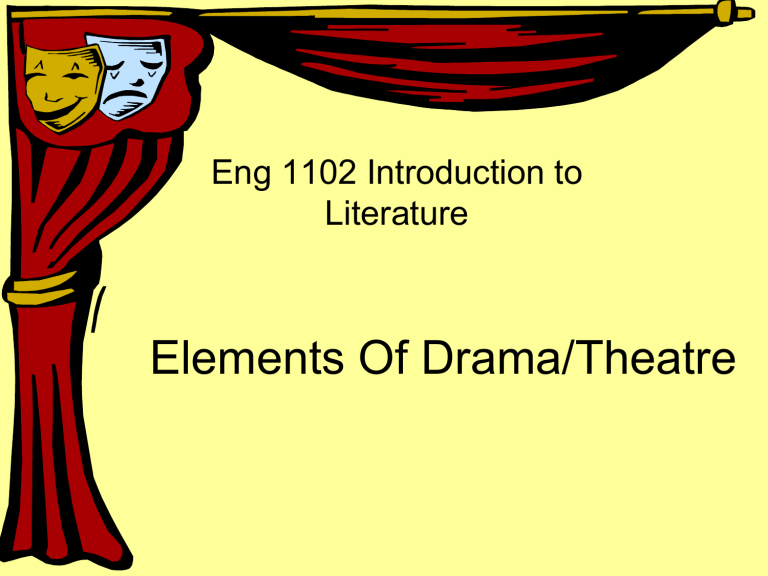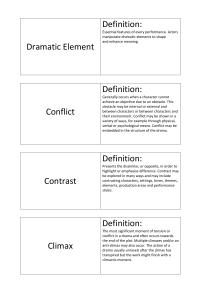
Eng 1102 Introduction to Literature Elements Of Drama/Theatre What is Drama? • Drama’ is an Ancient Greek word meaning ‘act’ or ‘deed’ • Drama is a type of narrative, usually fictional, that is performed. • Usually involves actors on stage in front of a live audience. The Elements of Drama Elements of Drama: The elements of drama, by which dramatic works can be analyzed and evaluated, can be categorized into three major areas: literary elements, technical elements, and performance elements. literary elements technical elements performance elements Literary Elements Freytag's Pyramid Literary Elements • Exposition- Introduces important background information to the audience • Information about the setting, events occurring before the main plot, characters' back stories, etc. • through dialogues, flashbacks, characters' thoughts, background details, in-universe media, or the narrator telling a back-story. Ex- In Antony and Cleopatra, Antony is torn between his duties as a Roman ruler and soldier and his desire to live in Egypt with his lover, Cleopatra. This inner conflict leads him to become embroiled in a war with Caesar, one of his fellow triumvirs • Rising action- a series of events build toward the point of greatest interest. The rising action of a story is the series of events . These events are generally the most important parts of the story since the entire plot depends on them to set up the climax and ultimately the satisfactory resolution of the story itself • Ex- In Antony and Cleopatra by William Shakespeare, Caesar lures Antony out of Egypt and back to Rome, and marries Antony to his sister, Octavia. Antony eventually returns to Egypt and Cleopatra, and Caesar prepares to lead an army against Antony. • Climax- The climax is the turning point, which changes the protagonist's fate. • The rising action of a story is the series of events that begin immediately after the exposition (introduction) of the story and builds up to the climax. These events are generally the most important parts of the story • the entire plot depends on them to set up the climax and ultimately the satisfactory resolution of the story itself. Ex- climax - Antony disgraces himself by fleeing the battle of Actium to follow Cleopatra, betraying his own image of himself as a noble Roman • Falling action- During the falling action, the conflict between the protagonist and the antagonist loosens • the protagonist wins or looses against the antagonist. • The falling action may contain a moment of final suspense, in which the final outcome of the conflict is in doubt. • Ex- Cleopatra abandons Antony during the second naval battle, leaving him to suffer an insurmountable defeat. • Dénouement- Comprises events from the end of the falling action to the actual ending scene of the drama or narrative. Conflicts are resolved, creating normality for the characters and a sense of catharsis, or release of tension and anxiety, • It is the unraveling or untying of the complexities of a plot. Literary Elements Character: a person portrayed in a artistic piece. drama, novel, or other Exposition is the “who, when, where and what” part of the play. Story organization: beginning, middle, end Conflict: the internal or external struggle between opposing forces, ideas, or interests that creates dramatic tension. Suspense: a feeling of uncertainty as to the outcome, used to build interest and excitement on the part of the audience. Literary Elements Theme: the basic idea of a play; the idea, point of view, or perception that binds together a work of art. Language: in drama, the particular manner of verbal expression, the diction or style of writing, or the speech or phrasing that suggests a class or profession or type of character. Style: the shaping of dramatic material, settings, or costumes in a deliberately nonrealistic manner. Literary Elements Soliloquy: a speech by a single actor who is ALONE on stage Monologue: a long speech made by one actor; a monologue may be delivered alone or in the presence of others. Technical Elements Scenery (set): the theatrical equipment, such as curtains, flats, backdrops, or platforms, used in a dramatic production to communicate environment Costumes: clothing and accessories worn by actors to portray character and period. Props: short for properties; any article, except costume or scenery, used as part of a dramatic production; any moveable object that appears on stage during a performance, from a telephone to a train. Technical Elements Lights: the placement, intensity, and color of lights to Help communicate environment, mood, or feeling Sound: the effects an audience hears during performance to communicate character, context, or environment Makeup: costumes, wigs, and body paint used to transform an actor into a character. Performance Elements Acting use of face, body, and voice to portray character Character motivation: the reason or reasons for a character’s behavior; an incentive or inducement for further action for a character Character analysis: in responding to dramatic art, the process of examining how the elements of drama—literary, technical, and performance—are used empathy: the capacity to relate to the feelings of another. Performance Elements Speaking: the mode of expression or delivery of lines Breath control: proper use of the lungs and diaphragm muscle for maximum capacity and efficiency of breath for speaking Vocal expression: how an actor uses his or her voice to convey character Inflection: change in pitch or loudness of the voice. Projection: how well the voice carries to the audience Speaking style: the mode of expression or delivery of lines Diction: selection and pronunciation of words; clarity of speech. Performance Elements Nonverbal expression: Gestures any movement of the actor’s head, shoulder, arm, hand, leg, or foot to convey meaning Body alignment physiologically correct posture and use of the body to ensure the maximum capacity and efficiency of breathing and movement Facial expression physical and vocal aspects used by an actor to convey mood, feeling, or personality Character blocking the path formed by the actor’s movement on stage, usually determined by the director with assistance from the actor and often written down in a script using commonly accepted theatrical symbols Movement stage blocking or the movements of the actors onstage during performance; also refers to the action of the play as it moves from event to event.

